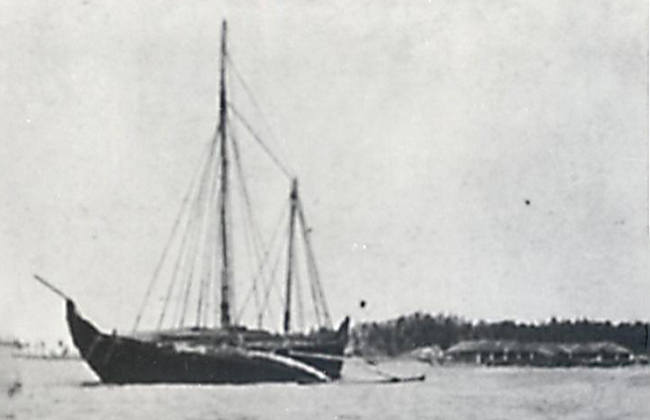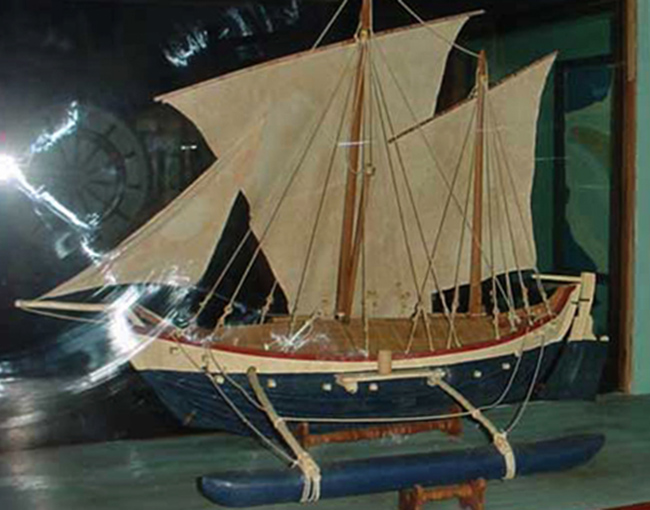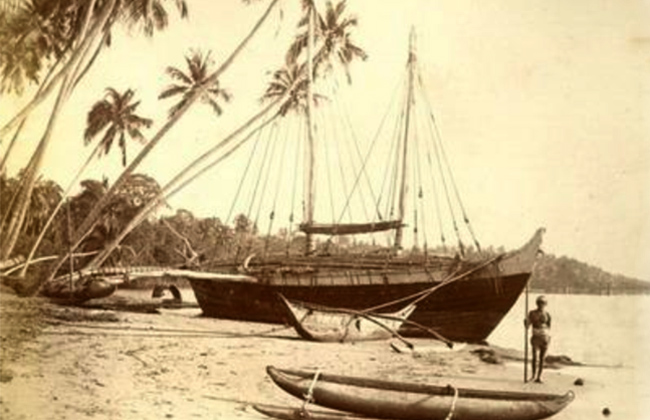‘Don Bastian de Silva Jayasuriya was another owner of maadal at Magalle (in the environs of Galle) who is reputed to have prospered initially in his trading activities in the early nineteenth century and even controlled several dhonies or ships which traded with Burma. His new residence at Magalle was known as ‘Wasala Walauwa’ and his status was raised to that of a Mudaliyar of the Governor’s Gate in 1868.
Two of his daughters, Justina and Nona Baba Hamine, married into the aristocratic de Fonseka family of Kalutara.‘
– Michael Roberts, Caste Conflict and Elite Formation, 1982.
Don Bastian de Silva Jayasuriya Goonewardene seems to have been one of the great Karava Ship owner and Trader of the era. His many deeds are recorded in the following article and need not be repeated here. Even during the Dutch occupation, it is recorded that the King of Kandy sought the assistance of the Dutch to bring in priests from Arakan, Siam and other places. Don Bastian will go down in history as one of the few indigenous people who carried on a fruitful relationship with the people of Burma, and brought down many priests for the propagation of Buddhism in this country.
The search to find the names of the two de Fonseka family members who married his daughters continues. So far only one name comes up within the family circle. Lorna de Fonseka recalls the story as follows.
‘One of the daughters I think married Henry Fredrick de Fonseka’s father (John Henry de Fonseka). She was only a teenage girl of 13 years or so when she was given in marriage. She came in a palanquin with lots of slaves as part of her dowry.’
Don Bastian de Silva Jayasuriya.
- Don Juan de Silva Jayasuriya Gunawardene married Angeltina de Fonseka
daughter of Manuel de Fonseka.- d. Alice Gunawardene md. Bastian Wickremasinghe.
- d. Sophia Wickremasinghe md. Samson Perera Abeysekera Wijetunge.
- d. Pearl Wijetunge md Anthony Roland Fairlye de Silva.
- d. Shihan de Silva Jayasuriya md Dr Hemal Dhammika Jayasuriya.
- Johan Heshan Jayasuriya.
- d. Shihan de Silva Jayasuriya md Dr Hemal Dhammika Jayasuriya.
- d. Pearl Wijetunge md Anthony Roland Fairlye de Silva.
- d. Sophia Wickremasinghe md. Samson Perera Abeysekera Wijetunge.
- d. Alice Gunawardene md. Bastian Wickremasinghe.
- One of the daughters Justina married from the De Fonseka Families of Kalutara.
- One of the daughters Nona baba Hamine married from the De Fonseka Families of Kalutara – possibly John Henry de Fonseka.
SADDHARMA YUKTIKA BHIKSHU VAMSAYA
A Historical account of the Saddharma Yuktika Sect; in Ceylon.
Compiled by Ven. Elder Piyatissa of Magalle, Incumbent of Gangaramaya Viharaya, Padawtota, Magalle.
Published by Messrs F. B. Charles de Silva and Brothers of Ahangama in 1946 to celebrate the centenary of the formation of the ‘Saddharma Yuktika’ Sect by the Venerable Matara Dharmarama Thero.
Printed at The Mahajana Press Ltd, 132, Stanley Place, Colombo.
Page 24: Don Bastian de Silva Jayasuriya Goonewardane, Mudaliyar of the Governor’s Gate
In 1841, Don Bastian de Silva Jayasuriya Goonewardane (referred as Don Bastian) of Padawthota, Magalle attended a ‘Pirith Pinkama’ preached by the Matara Sri Dharmarama thero and was so taken by the experience that in due course he built the Gangaramaya Viharaya in Galle, and made it the chief temple of the priest. He was also instrumental in the formation of the Saddharma Yuktika Nikaya (or sect.) with Matara Sri Dharmarama Thero. The book, which traces the formation of this Buddhist sect., also gives us great detail about its chief ‘dayaka’ or benefactor.
Don Bastian was a wealthy owner of ships (dhonies) and ‘maadal’ fishing nets, and lived in the environs of Galle, known as Maagalle. His ships conducted trade along the coast and even navigated up to Burma to indulge in trade with that country. His ships have been used to carry messages and gifts to the King and Court of Burma, and more importantly to bring Bhikkus from that country to strengthen the Saddharma Yuktika Sect. and to preach the message of the Bhudda. The book reproduces in Singhalese the translations of letters carried between the chief minister of Burma and Don Bastian. In these letters he seeks permission to bring ‘Sangha’ to preach the words of Buddhism in the temple, and offers safe passage in his ships, some of which were anchored in Rangoon. The letter speaks of first having to transfer the ‘Sangha’ to Hansawathi Nuwara by steamship and onwards to Rangoon to board his ship anchored there. Other letters speak of the gifts exchanged between the court of Burma and Don Bastian. The gifts sent by him include ‘Pushparaaga’ and ‘Sudunil’ gems and hundreds of low value gem stones, including lace items and finely carved furniture.
On his invitation two ministers of the King of Siam and a chief Monk from ‘Ratna Kasinara Nuwara’ seem to have arrived here in 1852. Don Bastian who in his prime was a wealthy ship owner with assets over rupees two million died in the Buddha year 2416. At the time of his death it seems that he was bankrupt, having lost many a ship at sea. After his death, his wife Helena Jayasuriya Goonewardene left Galle for good.
Page 70: History of the Gangaramaya Viharaya:
Don Bastian Mudaliyar who was looking for a suitable land to build a temple for the Matara Sri Dharmarama thero, bought a beautiful piece of land belonging to three Moors, and filled and prepared the land at great expense. The land bordered on two sides by the Moragoda Ela and the Pettigala Ela was used to build the temple, which was subsequently named the Padawthota Gangaramaya Viharaya. The Mudaliyar, with the assistance of the people built a great ‘Chaitya’ (Dagaba) of 30 Riyans, and built a great decorative arch (thorana) and a ‘Sandakada Pahana’ modeled on the ones found at Anuradhapura , at the entrance to the temple. A ‘Bo’ sapling brought from the great Sri Maha Bhodiya in Anuradhapura, was also planted by his own hands and brought up. He also built a three-storied preaching hall and the walls, railings and the moat round the temple.


